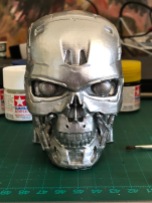I have started developing a raycasting game in Python (using PyGame) as a learning exercise and to get a better understanding of the math and techniques involved.

Raycasting is a graphic technique used to render pseudo-3D graphics based on a 2D game world. The best-known example of a raycasting engine used in a computer game is probably Wolfenstein 3D, developed by id Software in 1992.
So firstly, here are some resources I used to upskill and get my head around the topic:
YouTube tutorial series by Standalone Coder. These videos are in Russian, but the YouTube subtitles do a good enough job to follow along.
YouTube tutorial series by Code Monkey King.
Lode’s Computer Graphics Tutorial.
Lastly, I recommend the book Game Engine Black Book: Wolfenstein 3D by Fabien Sanglard, it is not an easy read, but it gives excellent insight into the development of Wolfenstein 3D and a great deal of information into the intricate details of Raycasting and texture mapping.
The Basics of Raycasting
The first thing to understand is that Raycasting is not true 3D, but rather rendering a 2D world in pseudo 3D. Therefore, all movement and game positions consist of only x and y positions, with no height or z positions.
The entire game world consists of a grid, with some blocks in the grid being populated with walls and others being empty. An example of this is shown in the picture below:
In the current version of the game, the world map is implemented as a list of strings, where each character in the string represents a block in the grid. The ‘0’ character represents an empty block, and all other numbers represent a wall. The numbers ‘1’, ‘2’, and ‘3’ are used to show different wall textures according to the different numbers, something covered later in this post.
game_map = [
'11111111111111111111',
'10000000000003330001',
'10011100000000000001',
'10030000000000000001',
'10020000000000300001',
'10020001110000000001',
'10000330000000000001',
'10000330000000000001',
'10000330000000000001',
'10000330000000000001',
'10000330000000000001',
'10000330000000000001',
'10020000000000300001',
'10020001110000000001',
'10000330000000000001',
'10000330000000000001',
'10020000000000300001',
'10020001110000000001',
'10000330000000000001',
'11111111111111111111'
]This is then converted into a dictionary as follows:
world_map = {}
for j, row in enumerate(game_map):
for i, char in enumerate(row):
if char != '0':
if char == '1':
world_map[(i * GRID_BLOCK, j * GRID_BLOCK)] = '1'
elif char == '2':
world_map[(i * GRID_BLOCK, j * GRID_BLOCK)] = '2'
elif char == '3':
world_map[(i * GRID_BLOCK, j * GRID_BLOCK)] = '3'The player is placed on this grid with a x and y coordinates determining the player’s position on the grid. Along with the x and y coordinates, the player also has a viewing angle, i.e., a direction the player is facing.
Now that we have the foundation in place, we can get to the raycasting.
To understand this concept, imagine a line originating from the player and heading off in the direction the player is facing.
Now, this is not an endless line, but rather a line that keeps expanding from one world grid line to the next. (this is done with a for loop).
At every point where this ‘ray’ intersects a grid line on the game world, a check is done to determine if the grid line in question is a wall or not.
If it is a wall, the loop expanding the line is stopped, and the x and y coordinates where the wall was intersected will be noted. We will use this a bit later when drawing the pseudo-3D rendering of the world.
The above is the simplest form of raycasting. However, a single ray will not give us a usable amount of information to do the pseudo-3D render with. This is where a player’s FOV (field of view) and more rays come in.
The Player FOV is an angle on the game world originating at the player and extending out in a triangular form. This determines where the player’s visible range at present begins and ends. For this game, I will use a FOV of 60% (i.e., pi/3).
To change the FOV, the following can be used as a guide:
| Radians | Degrees |
| π / 6 | 30° |
| π / 4 | 45° |
| π / 3 | 60° |
| π / 2 | 90° |
| π | 180° |
Within this FOV, several rays will be generated, exactly as per the single one in the example discussed earlier.
In this game, a value of 480 rays has been defined, which will be generated within the FOV, so the process above for a single ray will be repeated 480 times, with each ray cast having its angle increased by a marginal amount from the previous ray.
The angle of the first ray will be determined as follows:
Starting angle = Player Angle – Half the FOV
Where Player Angle is defined as the center point of direction player is facing.
For each subsequent ray, the angle of the ray will be increased by a delta angle calculated as followed:
Delta Angle = FOV/Number of Rays
This will allow for a sufficient set of information to draw a pseudo-3D rendering from.
To see how this is implemented, please look at lines 6 to 39 in the raycasting.py file.
Sine and Cosine functions are used to determine the intersecting coordinates, and if you require a refresher on these functions, I recommend this web article from mathisfun.com.
For calculating the y coordinate where the ray intersects with a wall, the following formula is used:
y = (player y) + depth * sin(ray angle)
And to calculate the x coordinate where the ray intersects with a wall, the following formula is used:
x = (player x) + depth * cos(ray angle)
For depth value in the above formulas, a sequence of numbers would usually be looped through, starting at 0 and ending at some defined maximum depth.
The above formulas would then be executed at each new depth level to get the corresponding x and y coordinates.
This does provide the desired results, but it is not very optimized.
To improve the performance of this operation, the Digital Differential Analyzer (DDA) algorithm will be used. At a high level, the DDA algorithm functions by not checking every pixel of the 2D game world for an intersection of a ray and a wall but only checking on the grid lines of the 2D world (the only place where walls can occur).
To implement the DDA algorithm, we are going to need four extra variables in conjunction with the Player x and y coordinates, namely:
dx and dy – these two variables will determine the step size to the next grid line. Based on the direction of the angle, these either have the value of 1 or -1.
gx and gy – This will be the x and y coordinates of the grid lines that will be iterated through, starting with the grid line the closest to the player x and y position. The initial value is determined using the following function, located in the common.py file:
def align_grid(x, y):
return (x // GRID_BLOCK) * GRID_BLOCK, (y // GRID_BLOCK) * GRID_BLOCK
This will ensure that the returned x and y coordinates are located on the closet grid line (based on game world tile size). For reference, the // operator in Python is floor division and rounds the resulting number to the nearest whole number down.
To determine the depth to the next y-axis grid line, the following equation will be used:
Depth Y = (gx – player x) / cos (ray angle)
And to determine the depth of the next x-axis grid line, this equation is used:
Depth X = (gy – player y) / sin (ray angle)
The below two code blocks implement what was just described, the first block of code is to determine intersections with walls on the y axis of the world map:
# checks for walls on y axis
gx, dx = (xm + GRID_BLOCK, 1) if cos_a >= 0 else (xm, -1)
for count in range(0, MAX_DEPTH, GRID_BLOCK):
depth_y = (gx - px) / cos_a
y = py + depth_y * sin_a
tile_y = align_grid(gx + dx, y)
if tile_y in world_map:
# Ray has intersection with wall
texture_y = world_map[tile_y]
ray_col_y = True
break
gx += dx * GRID_BLOCKAnd the next block of code is to determine intersections with walls on the x axis of the world map:
# checks for walls on x axis
gy, dy = (ym + GRID_BLOCK, 1) if sin_a >= 0 else (ym, -1)
for count in range(0, MAX_DEPTH, GRID_BLOCK):
depth_x = (gy - py) / sin_a
x = px + depth_x * cos_a
tile_x = align_grid(x, gy + dy)
if tile_x in world_map:
# Ray has intersection with wall
texture_x = world_map[tile_x]
ray_col_x = True
break
gy += dy * GRID_BLOCKtexture_x and texture_y are used to store the index of the texture to display on the wall. We will cover this later in this post.
Now that we have the raycasting portion covered, which is the most complex, we can focus on simply rendering the pseudo-3D graphics to the screen.
At a very high level, the basic concept of how the pseudo-3D graphics will be created, is to draw a rectangle for every ray that has intersected a wall. The x position of the rectangle will be based on the angle of the ray. The y position will be determined based on the distance of the wall from the player, with a width of the rectangle equal to the distance between the rays (calculated with Window resolution width / Number of Rays) and a user-defined height.
This will create a very basic pseudo-3D effect, and it would be much nicer using textured walls.
To implement textured walls the concept remains the same, but instead of just drawing rectangles, we will copy a small strip from a texture image and draw that to the screen instead.
In the code blocks above, there were two variables texture_x and texture_y. Where a wall intersection did occur these variables will contain a value of ‘1’, ‘2’ or ‘3’ based on the value in the world map, and these correspond to different textures that are loaded in a dictionary as follows:
textures = {
'1': pygame.image.load('images/textures/1.png').convert(),
'2': pygame.image.load('images/textures/2.png').convert(),
'3': pygame.image.load('images/textures/3.png').convert(),
'S': pygame.image.load('images/textures/sky.png').convert()
}Firstly the correct section of the texture needs to be loaded based on the ray’s position on the wall. This is done as follows:
wall_column = textures[texture].subsurface(offset * TEXTURE_SCALE, 0, TEXTURE_SCALE, TEXTURE_HEIGHT)Depending if it is for a x-axis or y-axis wall, the follwoing values will be as follows:
For a x-axis wall:
texture = texture_x
offset = int(x) % GRID_BLOCK
Where x is the x coordinate of the wall intersection.
And for a y-axis wall:
texture = texture_y
offset = int(y) % GRID_BLOCK
Where y is the y coordinate of the wall intersection.
Next, the section of the texture needs to be resized correctly based on its distance from the player as follows:
wall_column = pygame.transform.scale(wall_column, (SCALE, projected_height))Where the values are determined as below:
projected_height = min(int(WALL_HEIGHT / depth), 2 * resY)
resY = Window Resolution Height
For a x-axis wall:
depth = max((depth_x * math.cos(player_angle – cur_angle)),0.00001)
For a y-axis wall:
depth = max((depth_y * math.cos(player_angle – cur_angle)),0.00001)
The last thing to do then is to draw the resized texture portion to the screen:
sc.blit(wall_column, (ray * SCALE, HALF_HEIGHT - projected_height // 2))The above operations of copying a section of a texture, resizing it, and drawing it to the screen is done for every ray that intersects a wall.
The last thing to do and by far the least complex is to draw in the sky box and the floor. The sky box is simply an image, loaded in the texture dictionary under the ‘S’ key, which is drawn to the screen. The sky box is drawn in three blocks:
sky_offset = -5 * math.degrees(angle) % resX
self.screen.blit(self.textures['S'], (sky_offset, 0))
self.screen.blit(self.textures['S'], (sky_offset - resX, 0))
self.screen.blit(self.textures['S'], (sky_offset + resX, 0))This ensures that no gap appears as the player turns and creates the impression of an endless sky.
Lastly, for the floor, a solid color rectangle is drawn as below:
pygame.draw.rect(self.screen, GREY, (0, HALF_HEIGHT, resX, HALF_HEIGHT)) For reference, the following PyGame functions are used in the game up to this point:
pygame.init
Used to initialize pygame modules and get them ready to use.
pygame.display.set_mode
Used to initialize a window to display the game.
pygame.image.load
Used to load an image file from the supplied path into a variable to be used when needed.
pygame.Surface.subsurface
Used to get a copy of a section of an image (surface) based on the supplied x position,y position, width, and height values.
pygame.transform.scale
Used to resize an image (surface) to the supplied width and height.
pygame.Surface.blit
Used to draw images to the screen.
pygame.display.flip
Used to update the full display Surface to the screen.
pygame.Surface.fill
Used to fill the display surface with a background color.
pygame.draw.rect
Used to draw a rectangle to the screen (used for the floor).
Also used pygame.key.get_pressed, pygame.event.get and pygame.mouse methods for user input.
Collision Detection
Because the game plays out in a 2D world, collision detection is rather straightforward.
The player has a square hitbox, and every time the player inputs a movement, the check_collision function is called with the new x and y positions the player wants to move to. The function then uses the new x and y positions to determine the player hitbox and check if it is in contact with any walls; if so, the move is not allowed. Otherwise, the player x and y positions are updated to the new positions.
Here is the check_collision function that forms part of the Player class:
def check_collision(self, new_x, new_y):
player_location = mapping(new_x , new_y)
if player_location in world_map:
# collision
print("Center Collision" + str(new_x) + " " + str(new_y))
return
player_location = mapping(new_x - HALF_PLAYER_MARGIN, new_y - HALF_PLAYER_MARGIN)
if player_location in world_map:
# collision
print("Top Left Corner Collision" + str(new_x) + " " + str(new_y))
return
player_location = mapping(new_x + HALF_PLAYER_MARGIN, new_y - HALF_PLAYER_MARGIN)
if player_location in world_map:
# collision
print("Top Right Corner Collision" + str(new_x) + " " + str(new_y))
return
player_location = mapping(new_x - HALF_PLAYER_MARGIN, new_y + HALF_PLAYER_MARGIN)
if player_location in world_map:
# collision
print("Bottom Left Corner Collision" + str(new_x) + " " + str(new_y))
return
player_location = mapping(new_x + HALF_PLAYER_MARGIN, new_y + HALF_PLAYER_MARGIN)
if player_location in world_map:
# collision
print("Bottom Right Corner Collision" + str(new_x) + " " + str(new_y))
return
self.x = new_x
self.y = new_yHere is a video of the current version of the game in action:
The current version of this game is still a work in progress, but if you are interested, the source code can be downloaded here and the executable here.
Some of the next things on the to-do list are loading levels from the file, adding sprites to the game world, and adding some interactive world items, such as doors that open and close.
I will keep creating posts on this topic as I progress with this project.

































































































































